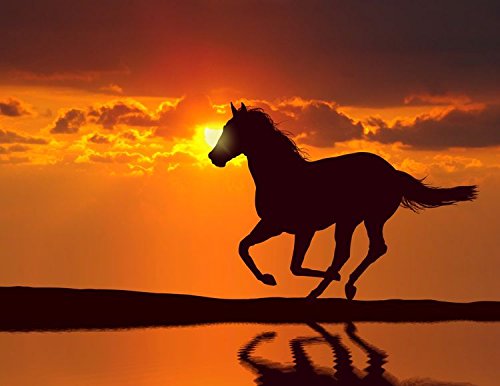Horses which are wild or semi-wild. A mustang is an example of a feral horse.
Mustang

Mustang Running Horse at Beautiful Sunset Animal Nature Home Decor Wall Poster 43 x 33 cm
The Mustang is a feral horse found now in the western United States. The name Mustang comes from the Spanish word mesteño or monstenco meaning wild or stray. Originally these were Spanish horses or their descendants but over the years they became a mix of numerous breeds.
These were the horses which changed the lives of the Native Americans living in or near the Great Plains. As European settlers came farther west they brought their horses with them. Some were lost to Indian raids, others were freed as wild stallions ,tore down fences to add the tame mares to his herd or tame horse escaped from settlers as the original horses had escaped from the Spanish.
Mustang have no overall characteristics because different breeds of horses have contributed to the development of wild horses in various areas. Draft horses were popular in certain areas among settlers, and hot-blooded horses were more popular in others. Some are large and full-bodied, while others are smaller and daintier in appearance. The abundance of or lack of forage also helps determine size. Horses range from 13 to 16 hands high and are all colors, including black, bay, dun, palomino, gray and spotted.
Many people think that mustangs are simply wild horses rather than a specific breed. These horses bred with other types of horses, including quarter horses and draft horses, to create the breed we know today.
Like other mammals, mustangs have live births. Their babies are called foals. Mares carry their foal for an 11-month gestation period. Mustangs typically give birth to their foals in April, May, or early June.This gives the young horse time to grow before the cold months of the year.
Most of the mustang populations are found in the Western states of Montana, Idaho, Nevada, Wyoming, Utah, Oregon, California, Arizona, North Dakota and New Mexico. Some also live on the Atlantic coast and on islands such as the Sable, Shackleford, Assateague and Cumberland Islands.
Mustangs live in large herds. The herd consists of one stallion, around eight females and their young, though separate herds have been known to blend when they are in danger. The herd is led by a female horse, or mare, and a stallion that is over 6 years of age. In dangerous situations, the head mare will lead her heard to safety, and the stallion will stay and fight.
Herds spend most of their time grazing on grasses, though it is not unusual to see them playing or snuggling together for a nap. Often, when it looks like they are fighting, young mustangs are actually playing a game, much like when human children wrestle.
In the wild, Mustangs can live up to 40 years. Hurt or disabled horses are protected by the herd and can live remarkably long lives when compared with other animal species that live in the wild.
If you have any information,questions, or feedback you would like to include in this webpage.
Please email momo19@naturekingdoms.com or leave your comments below.